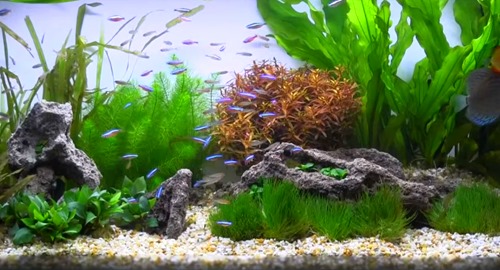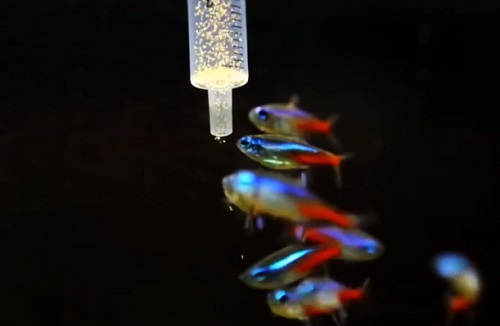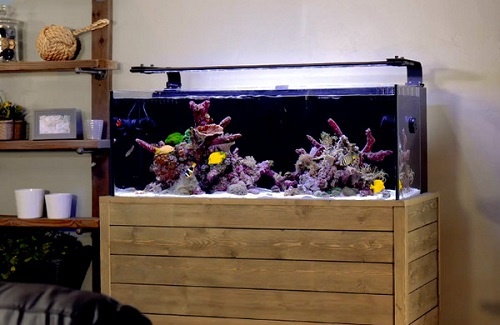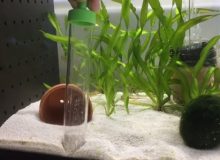How a Fish Tank Can Calm Your Mind and Boost Your Well-Being
Home aquariums offer a multifaceted experience, blending aesthetic beauty, educational opportunities, and health benefits. They serve as miniature ecosystems that captivate the senses, foster learning, and promote well-being. From sparking curiosity about aquatic life to enhancing the ambiance of a space, aquariums provide a unique way to enrich daily life. Below, we explore ten key benefits of maintaining a home aquarium, each contributing to personal growth, relaxation, environmental awareness, and social learning.
- 1. Enjoying a New Hobby
- 2. Relaxation and Stress Relief
- 3. Caring for Nature
- 4. Learning About Aquatic Ecosystems
- 5. Enhancing Visual Appeal
- 6. Learning Tool for Children
- 7. Better Health Parameters
- 8. Calming Effect on ADHD and Alzheimer’s Patients
- 9. Improved Productivity
- 10. Socializing Lessons
1. Enjoying a New Hobby

Maintaining a home aquarium introduces a captivating hobby that brings vibrancy and purpose to daily life. Caring for a diverse array of fish, aquatic plants, and microorganisms involves learning about their specific needs, from water chemistry to feeding schedules, creating a dynamic and engaging experience. This nurturing process fosters a sense of accomplishment as you watch your aquatic ecosystem thrive, transforming routine care into a source of joy and discovery for hobbyists of all ages.
The allure of an aquarium lies in its ability to become a focal point in the home, drawing family and friends together to marvel at the colorful fish darting through the water or responding to familiar faces. Whether it’s selecting new species, designing the tank’s layout, or observing the unique behaviors of its inhabitants, aquarium keeping sparks curiosity and creativity. This shared activity not only strengthens family bonds but also turns the aquarium into a lively, joyful hub that enhances the home’s atmosphere.
Moreover, the hobby is endlessly customizable, catering to both beginners and seasoned enthusiasts. From small tanks with a few guppies to elaborate setups with exotic species and intricate aquascapes, there’s always something new to explore. This versatility ensures that aquarium keeping remains a stimulating diversion, offering a refreshing break from the monotony of everyday routines and fostering a lifelong passion for aquatic life.
2. Relaxation and Stress Relief

Aquariums are renowned for their calming effects, providing a serene escape from the pressures of modern life. Watching fish glide gracefully through the water, surrounded by gently swaying plants and bubbling filters, creates a tranquil environment that soothes the mind and reduces stress. Studies, such as those conducted in 2015, have shown that observing aquarium fish can lower heart rates and promote relaxation, making it an effective tool for improving mental well-being and aiding in more restful sleep.
In today’s fast-paced world, stress is a common trigger for health issues such as high blood pressure, anxiety, and insomnia. Placing an aquarium in a home, office, or public space like a dentist’s office or hospital waiting room offers a natural antidote to these challenges. The rhythmic movements of fish and the soft glow of tank lighting create a meditative atmosphere, encouraging mindfulness and helping individuals unwind after a hectic day.
Beyond personal relaxation, aquariums contribute to a healthier indoor environment by fostering a sense of calm that benefits everyone in the space. Whether in a living room, workplace, or gym, the presence of an aquarium can transform a corner into a peaceful retreat, promoting emotional balance and resilience. This restorative quality makes aquariums a valuable addition to any setting where stress relief is a priority.
3. Caring for Nature

Maintaining a home aquarium cultivates a deeper appreciation for nature by simulating a delicate aquatic ecosystem that requires careful attention to thrive. Monitoring water quality, temperature, and nutrient levels teaches aquarium owners about the fragility of marine environments and the importance of ecological balance. This hands-on experience fosters empathy for aquatic life and a broader understanding of environmental stewardship, encouraging sustainable practices that extend beyond the tank.
Involving family members, especially children, in aquarium care imparts valuable lessons in responsibility and compassion. Feeding fish, cleaning the tank, and ensuring optimal conditions require diligence and attention to detail, as fish are sensitive creatures whose health depends on precise care. These tasks not only educate young learners about the needs of living organisms but also instill a lifelong respect for nature, making the aquarium a powerful tool for environmental education.
Additionally, aquariums bring the wonders of marine life into the home, offering a unique opportunity to connect with aquatic ecosystems without leaving the house. By nurturing fish and plants, individuals gain insight into the complexities of marine habitats, from coral reefs to freshwater rivers. This intimate connection with nature inspires a sense of responsibility to protect our planet’s waterways, making aquarium keeping a meaningful way to contribute to conservation awareness.
4. Learning About Aquatic Ecosystems

A home aquarium serves as a living classroom, offering a window into the complexities of aquatic ecosystems. Unlike terrestrial environments, aquatic systems operate under a delicate balance of water chemistry, temperature, and biological interactions, which aquarium owners must understand to ensure their tank thrives. By managing elements like pH, hardness, and nutrient levels, hobbyists gain a hands-on education in the interconnected dynamics of aquatic life, fostering a deeper appreciation for the intricacies of marine and freshwater habitats.
Each aquarium is a unique microcosm, hosting not only fish but also algae, plants, and microorganisms that interact in distinct ways. Factors such as the type of food added, cleaning frequency, and waste accumulation influence the tank’s health, requiring ongoing observation and adjustment. This process of studying and implementing care strategies teaches valuable lessons about ecological balance, making aquarium keeping an engaging way to learn about environmental science and the delicate relationships that sustain life underwater.
The educational value extends beyond the hobbyist to family members and visitors, who can observe how different species coexist and adapt to their environment. For instance, watching how plants oxygenate the water or how fish respond to changes in light fosters curiosity about natural processes. This immersive learning experience transforms the aquarium into a dynamic tool for exploring the wonders of aquatic ecosystems, encouraging a lifelong interest in biology and environmental stewardship.
5. Enhancing Visual Appeal
A home aquarium is a visual masterpiece, transforming any space into a vibrant, dynamic display of color and movement. Owners can curate their tank with a variety of fish, from the shimmering neon tetras to the majestic bettas, creating a kaleidoscope of hues that captivates the eye. The addition of aquatic plants, colorful gravel, and decorative elements like driftwood or rocks further enhances the aesthetic, allowing for personalized designs that reflect individual style and creativity.
The clarity of clean water, combined with strategic lighting, elevates the aquarium’s allure, highlighting the graceful movements of fish and the subtle sway of plants. Subtle lighting effects, such as soft blue or warm white LEDs, can amplify the tank’s visual impact, creating a serene or dramatic ambiance depending on the setup. This ever-changing spectacle not only beautifies the home but also serves as a conversation starter, drawing attention and admiration from guests and family members alike.
Beyond its decorative appeal, an aquarium adds a sense of life and energy to a room, making it feel more inviting and dynamic. Whether placed in a living room, office, or bedroom, the tank’s vibrant ecosystem contrasts with static decor, offering a living artwork that evolves daily. This visual delight makes aquariums a versatile and impactful way to enhance the aesthetic of any space, blending nature and artistry in a unique, captivating form.
6. Learning Tool for Children
Aquariums are powerful educational tools for children, introducing them to the responsibilities and joys of caring for living creatures. By participating in tasks like feeding fish, monitoring water quality, and cleaning the tank, young learners develop a sense of duty and compassion while cultivating an early love for aquatic life. These hands-on activities teach practical skills, such as measuring pH or understanding feeding schedules, which foster discipline and curiosity about the natural world.
In educational settings, aquariums serve as innovative teaching aids, bringing subjects like biology, chemistry, and animal behavior to life. Children can observe firsthand how fish interact with their environment, how plants contribute to water oxygenation, or how water parameters affect ecosystem health. These tangible lessons make abstract concepts more accessible, sparking interest in science and encouraging critical thinking about ecological systems and their preservation.
The engaging nature of aquariums also promotes family bonding, as children and parents collaborate on tank maintenance and share in the excitement of watching fish grow and thrive. This shared experience not only strengthens relationships but also instills lifelong values of responsibility and environmental awareness. By nurturing a child’s connection to nature, aquariums lay the foundation for a deeper understanding of science and a commitment to caring for the planet.
7. Better Health Parameters
Aquariums contribute significantly to physical and mental health by creating a calming environment that reduces stress and promotes relaxation. Observing fish swim leisurely through the water has been shown to lower blood pressure and heart rate, as demonstrated in controlled studies from 2015, which found that even fishless water tanks induce a sense of calm, with effects amplified by the presence of fish. This tranquil atmosphere helps individuals manage stress more effectively, mitigating its detrimental impact on conditions like hypertension and anxiety.
Beyond stress relief, aquariums are linked to improved sleep quality and better pain management, particularly for dental patients, as the soothing visuals help distract from discomfort. The meditative quality of watching fish also enhances concentration, making it easier to focus on tasks or unwind after a demanding day. These benefits are particularly valuable in high-stress environments, such as homes, offices, or medical facilities, where aquariums serve as natural tools for fostering emotional and physical well-being.
The health advantages of aquariums extend to creating a restorative indoor environment that benefits all occupants. By providing a serene focal point, aquariums encourage mindfulness and emotional resilience, contributing to overall mental clarity and relaxation. This holistic impact underscores the value of aquariums as more than just decorative features, positioning them as powerful allies in promoting better health and a higher quality of life.
8. Calming Effect on ADHD and Alzheimer’s Patients

Aquariums have a profound calming effect on individuals with ADHD and Alzheimer’s disease, offering a non-invasive way to alleviate symptoms associated with these conditions. For children with ADHD, the gentle movements of fish and the serene ambiance of an aquarium can help reduce hyperactivity and improve focus, providing a soothing distraction that promotes calmness. Similarly, for Alzheimer’s patients, the tranquil environment created by an aquarium can reduce agitation and aggressive behavior, as supported by a Purdue University study, which noted marked improvements in patients exposed to fish tanks.
The rhythmic swimming of fish and the soft sounds of bubbling water create a sensory experience that engages without overwhelming, making aquariums particularly effective for managing neurological conditions. For children with ADHD, the visual stimulation of an aquarium can serve as a focal point to channel restless energy, while for Alzheimer’s patients, it offers a familiar and comforting presence that can evoke positive memories and emotions. This calming influence complements medical treatments, providing a natural and accessible way to enhance emotional well-being.
Incorporating an aquarium into homes or care facilities for individuals with ADHD or Alzheimer’s fosters a peaceful environment that benefits both patients and caregivers. The consistent, predictable nature of an aquarium’s ecosystem offers a sense of stability, which is particularly valuable for those with cognitive or behavioral challenges. By creating a serene space, aquariums contribute to improved quality of life, making them a valuable therapeutic tool for these populations.
9. Improved Productivity

In the era of remote work, maintaining focus and productivity can be challenging, especially with rising stress levels that disrupt concentration. Home aquariums offer a surprising solution by creating a calming environment that enhances mental clarity and work efficiency. The soothing presence of fish swimming in a well-lit tank helps reduce stress, allowing individuals to stay focused on tasks and complete work more effectively, ultimately making the workday more rewarding.
Research suggests that visual exposure to aquariums can improve concentration by providing a gentle, non-distracting stimulus that helps anchor attention. Taking short breaks to observe the tank can serve as a mental reset, boosting creativity and problem-solving abilities. This increased efficiency means more work can be accomplished in less time, reducing the pressure of deadlines and fostering a sense of accomplishment.
Aquariums also enhance the aesthetics of a home office, making the workspace more inviting and conducive to productivity. By transforming a desk or corner into a serene oasis, aquariums create an environment where focus thrives, benefiting professionals, students, or anyone seeking to optimize their performance. This subtle yet powerful influence underscores the value of aquariums as tools for enhancing both mental focus and workplace efficiency.

Aquariums quietly impart valuable lessons about coexistence and social dynamics by showcasing how different fish species interact within a shared environment. While the tank is often a peaceful space where diverse species coexist, occasional conflicts—such as one fish dominating resources or territory—mirror real-world social challenges. Observing these interactions teaches owners and children about sharing, resolving differences, and adapting to diverse personalities, offering insights into human social behavior.
The aquarium environment highlights the importance of balance and cooperation, as fish must share space, food, and oxygen to thrive. These natural dynamics provide a tangible way to learn about empathy, compromise, and the consequences of aggression or dominance, especially for young observers. By witnessing how fish navigate their community, children and adults alike gain a deeper understanding of the value of coexistence and mutual respect in diverse settings.
This living lesson extends beyond the tank, encouraging individuals to reflect on their own social interactions and the importance of fostering harmony in their communities. Aquariums serve as a microcosm of society, demonstrating how diverse individuals can coexist with mutual benefit when resources and space are managed thoughtfully. This makes aquarium keeping not only a visually engaging hobby but also a profound educational tool for cultivating social awareness and adaptability.







Leave a Reply